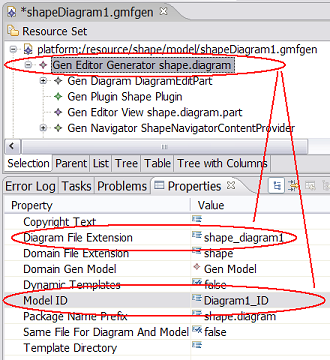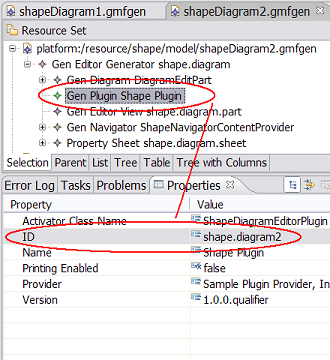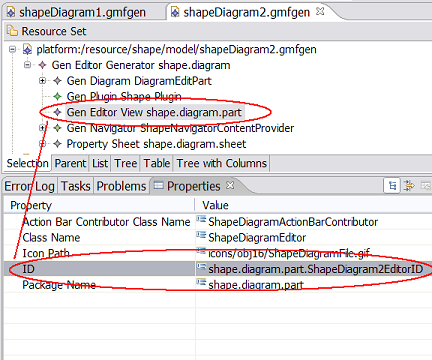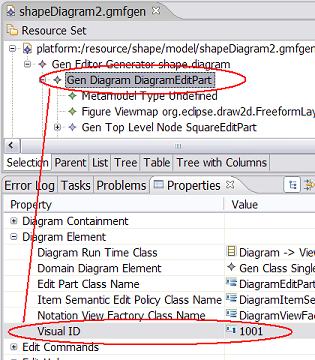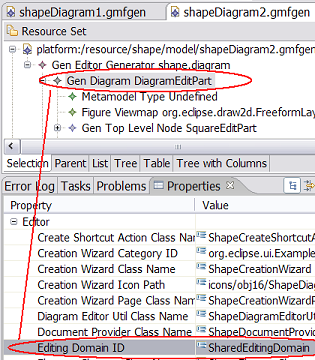Notice: this Wiki will be going read only early in 2024 and edits will no longer be possible. Please see: https://gitlab.eclipse.org/eclipsefdn/helpdesk/-/wikis/Wiki-shutdown-plan for the plan.
Difference between revisions of "Graphical Modeling Framework/Tips"
(→Image:New-small.gif Sharing single EditingDomain instance across several diagrams) |
(→Image:New-small.gif Sharing single EditingDomain instance across several diagrams) |
||
| Line 94: | Line 94: | ||
[[Image:Editor_ID.PNG]] | [[Image:Editor_ID.PNG]] | ||
| − | 4. Modify diagram2.trace file to use different visualID values then specified in diagram1.trace file - the easiest way is to replace | + | 4. Modify diagram2.trace file to use different visualID values then specified in diagram1.trace file - the easiest way is to replace “"200”-> “"210”, .., “"800” -> “"810” – and regenerate diagram2.gmfgen from diagram2.gmfmap |
5. Open diagram2.gmfgen and modify visualID property for GenDiagram to make it different then visualID of GenDiagram in diagram1.gmfgen: | 5. Open diagram2.gmfgen and modify visualID property for GenDiagram to make it different then visualID of GenDiagram in diagram1.gmfgen: | ||
| Line 123: | Line 123: | ||
</extension> | </extension> | ||
<!-- gmf generator persistent region end --> | <!-- gmf generator persistent region end --> | ||
| + | |||
| + | 10. Only one metamodelType could be registered for each EClass in scope of one EditingDomain. During this step you have to replace by specializationType declaration all the metamodelType declarations inside plugin.xml for diagram2 duplicating metamodelType declarations inside plugin.xml for diagram1 (having the same eclass attribute). Following part of plugin.xml: | ||
| + | |||
| + | <'''metamodelType''' | ||
| + | id="shape.diagram2.Diagram_1001" | ||
| + | name="Undefined" | ||
| + | kind="org.eclipse.gmf.runtime.emf.type.core.IHintedType" | ||
| + | '''eclass'''="Diagram" | ||
| + | '''edithelper'''="'''shape.diagram.edit.helpers.DiagramEditHelper'''"> | ||
| + | <param name="semanticHint" value="1001"/> | ||
| + | </'''metamodelType'''> | ||
| + | |||
| + | Should be replaced with: | ||
| + | |||
| + | <'''specializationType''' | ||
| + | id="shape.diagram2.Diagram_1001" | ||
| + | name="Undefined" | ||
| + | kind="org.eclipse.gmf.runtime.emf.type.core.IHintedType" | ||
| + | '''edithelperadvice'''="'''org.eclipse.gmf.runtime.emf.type.core.edithelper.AbstractEditHelperAdvice'''"> | ||
| + | <'''specializes''' id="shape.diagram1.Diagram_1000"/> | ||
| + | <param name="semanticHint" value="1001"/> | ||
| + | </'''specializationType'''> | ||
| + | |||
| + | ''<specializes>'' attribute for newly creates specializationTypes should point to the corresponding metamodeType id from plugin.xml generated for diagram1. | ||
Revision as of 14:48, 26 October 2006
I find those tips useful:
Contents
Creating New Elements And Corresponding Views
DeviceEditPart selectedElement = ...;
String compartemntsSemanticHint = NetworkVisualIDRegistry.getType(tests.mindmap.network.diagram.edit.parts.Device_ModulesCompartmentEditPart.VISUAL_ID);
Device_ModulesCompartmentEditPart modulesCompartment = (Device_ModulesCompartmentEditPart)selectedElement.getChildBySemanticHint(compartemntsSemanticHint);
IElementType type = NetworkElementTypes.Module_3001;
ViewAndElementDescriptor viewDescriptor = new ViewAndElementDescriptor(
new CreateElementRequestAdapter(new CreateElementRequest(type)),
Node.class,
((IHintedType) type).getSemanticHint(),
selectedElement.getDiagramPreferencesHint());
CreateViewAndElementRequest req = new CreateViewAndElementRequest(viewDescriptor);
CompoundCommand cmd = new CompoundCommand("Create 10 modules");
for (int i=0; i<10; i++) {
cmd.add(modulesCompartment.getCommand(req));
}
selectedElement.getDiagramEditDomain().getDiagramCommandStack().execute(cmd);
Change Names Of Newly Created Elements
Collection results = DiagramCommandStack.getReturnValues(cmd);
for (Object res: results) {
if (res instanceof IAdaptable) {
IAdaptable adapter = (IAdaptable) res;
View view = (View) adapter.getAdapter(View.class);
if (view != null) {
Module newMod = (Module)view.getElement();
SetRequest reqSet = new SetRequest(selectedElement.getEditingDomain(),
newMod, NetworkPackage.eINSTANCE.getNamedElement_Name(),
"ModX");
SetValueCommand operation = new SetValueCommand(reqSet);
selectedElement.getDiagramEditDomain().getDiagramCommandStack().execute(new
ICommandProxy(operation));
}
}
}
Create New Elements Using RecordingCommand and CanonicalEditPolicies
final Device dev = (Device)((View)selectedElement.getModel()).getElement();
TransactionalEditingDomain editingDomain = selectedElement.getEditingDomain();
editingDomain.getCommandStack().execute(new RecordingCommand(editingDomain) {
@SuppressWarnings("unchecked")
protected void doExecute() {
dev.setName("Morda13");
for (int i = 0; i < 5; i++) {
Module newMod = NetworkFactory.eINSTANCE.createModule();
newMod.setName("X26 - " + i);
dev.getModules().add(newMod);
}
}
});
 Remove Property Sheet altogether
Remove Property Sheet altogether
Add next method to the generated diagram editor class (usually <ModelName>DiagramEditor)
public Object getAdapter(Class type) {
if (type == IPropertySheetPage.class) {
return null;
}
return super.getAdapter(type);
}
 Sharing single EditingDomain instance across several diagrams
Sharing single EditingDomain instance across several diagrams
Generated code always creates new (own) instance of EditingDomain for each opened diagram editor. Since EditingDomain owns ResourceSet, different instances of domain model elements will be loaded for each opened diagram editor. Sometimes it is important to share the same domain model instances across several diagram editors (for example to get rid of synchronization problems). This leads us to the question of sharing same instance of EditingDomain across several generated diagram editors. Below you can find step by step description of necessary modifications you have to apply to the generated code to share the same EditingDomain instance between two diagrams of different types.
1. Make sure you have org.eclipse.gmf.bridge.trace plugin installed as a part of GMF SDK
2. Create diagram1.gmfmap, diagram2.gmfmap files and generate diagram1.gmfgen, diagram2.gmfgen. Ensure diagram1.trace and diagram2.trace files created.
3. Modify generated diagram1.gmfgen and diagram2.gmfgen files to use different Model IDs, Plugin IDs, Editor IDs. Optionally two different diagrams could has different diagram file extensions as well:
4. Modify diagram2.trace file to use different visualID values then specified in diagram1.trace file - the easiest way is to replace “"200”-> “"210”, .., “"800” -> “"810” – and regenerate diagram2.gmfgen from diagram2.gmfmap
5. Open diagram2.gmfgen and modify visualID property for GenDiagram to make it different then visualID of GenDiagram in diagram1.gmfgen:
6. Ensure both diagram1.gmfgen and diagram2.gmfgen are using the same EditingDomain ID:
7. Generate code for both diagram plugins.
8. In both generated ???DiagramEditor classes modify createEditingDomain() method to simply call to the super. implementation:
/**
* @generated NOT
*/
protected TransactionalEditingDomain createEditingDomain() {
return super.createEditingDomain();
}
9. Declare EditingDomain with the shared EditingDomain ID (see step 5.) inside plugin.xml for generated for diagram1:
<!-- gmf generator persistent region begin -->
<extension
point="org.eclipse.emf.transaction.editingDomains">
<editingDomain
factory="org.eclipse.emf.workspace.WorkspaceEditingDomainFactory"
id="SharedEditingDomain"/>
</extension>
<!-- gmf generator persistent region end -->
10. Only one metamodelType could be registered for each EClass in scope of one EditingDomain. During this step you have to replace by specializationType declaration all the metamodelType declarations inside plugin.xml for diagram2 duplicating metamodelType declarations inside plugin.xml for diagram1 (having the same eclass attribute). Following part of plugin.xml:
<metamodelType
id="shape.diagram2.Diagram_1001"
name="Undefined"
kind="org.eclipse.gmf.runtime.emf.type.core.IHintedType"
eclass="Diagram"
edithelper="shape.diagram.edit.helpers.DiagramEditHelper">
<param name="semanticHint" value="1001"/>
</metamodelType>
Should be replaced with:
<specializationType
id="shape.diagram2.Diagram_1001"
name="Undefined"
kind="org.eclipse.gmf.runtime.emf.type.core.IHintedType"
edithelperadvice="org.eclipse.gmf.runtime.emf.type.core.edithelper.AbstractEditHelperAdvice">
<specializes id="shape.diagram1.Diagram_1000"/>
<param name="semanticHint" value="1001"/>
</specializationType>
<specializes> attribute for newly creates specializationTypes should point to the corresponding metamodeType id from plugin.xml generated for diagram1.

